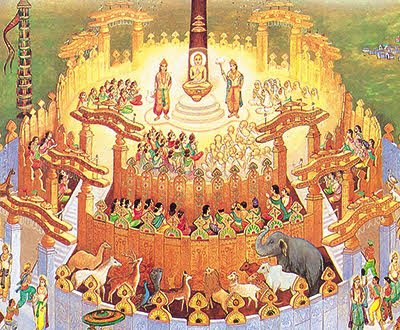
Then the Vayukumaras themselves, purged of pride, cleaned the surface of the earth for one yojana. The Meghakumaras sprinkled the earth with fragrant water; by fragrant vapors it made incense worship, as it were, to the Lord who was to come. The Vyantaras covered the surface of the earth with shining mosaics of gold and jewels like themselves with devotion.
They scattered five-colored fragrant flowers with their stalks turned downwards, as if they had sprung from the earth. In the four directions they created arches of jewels, rubies, and gold, as if they were neck-ornaments for their decoration. On top of them tall puppets looked as if embraced by friends, because of reflections made in each others’ bodies. Makaras made of glistening sapphire shone on the arches, giving the impression of banners abandoned by dying Makaraketu. White umbrellas looked like hansas of the quarters with joy arising from the Blessed One’s kevalajnanakalyana. Flags shone there, like arms raised by the goddess Earth, as if she herself had the desire to dance from great joy. Below the arches were the eight auspicious signs, svastika, etc., just like those on offering-stands.
Then the Vimanapatis made the uppermost rampart of jewels, so that it was like a girdle taken away from Ratnagiri. On it were battlements made of various gems which made the sky like a cloth of varied colors by their rays. In the middle part, moreover, the Jyotispatis made a wall of gold, as if the light of their own bodies had been collected together. They made battlements of jewels on it which resembled mirrors of jewels for the faces of the women of the gods and asuras. Outside of that, a wall of silver was made by the Bhavanapatis, as if Mt. Vaitadhya had become a circle through devotion. Above it there were extensive battlements like golden lotuses in the water of a divine pool. She (the earth), with the three ramparts made, looked as if she had a single ear-ring made of the wealth of the Bhavanadhipatis, Jyotispatis and Vaimanikas. There the arches of rubies, having rows of flags, appeared to have other flags made from the circles of rays. In each rampart four ornamental gate-ways were made, like pleasure-balconies of fourfold Dharma. At each gate jars of incense were set down by the Vyantara gods, sending forth creepers of smoke like pillars of sapphire. At each gate they made a tank with golden lotuses having four gates like the rampart of the samavasarana.
To the northeast inside the second wall, they made a dais for the Master’s rest. On both sides of the east gate of the first rampart stood two gold colored Vaimanika-gods as door-keepers. At its south gate at the sides stood two white Vyantara-gods, like reflections of each other, as door-keepers. At the west gate, two Jyotiskas stood as door-keepers, red like the sun and moon in the evening. At the sides of the north gate two Bhavanadhipatis stood as doorkeepers, like lofty black clouds. At the four gates of the second wall, in the same order beginning with the east, stood the goddesses Jaya, Vijaya, Ajita and Aparajita, all having one hand in the position bestowing fearlessness and the others holding noose, goad, hammer; moonstone, ruby, gold, and sapphire-colored, respectively. On the last rampart at each gate stood a Tumburu as doorkeeper, carrying a skull-crowned club, having a garland of human skulls, adorned with a coronet of matted hair.
In the midst of the samavasarana, a caitya-tree made by the Vyantaras, rising for three kos, indicated the rise of the Three Jewels. Beneath it, they made a platform with manifold jewels; on it they made a dais of incomparable gems. In the center of it to the east, they made next a jeweled lion-throne with a foot-stool, the essence of all the Sris, as it were. Above it were made three white umbrellas like three distinct signs of the Master’s lordship over the three worlds. On both sides Yaksas held two white chauris, as if loads of devotion to the Master, kept in the heart, had become external. Then at the gate of the samavasarana they made a dharmacakra, a wheel with remarkable light. Whatever else there was to be done, the Vyantaras did all that. They are the functionaries in the case of all samavasaranas.
Surrounded by crores of the four classes of gods, the Blessed One set out at daybreak to reach the samavasarana. Then the gods prepared nine golden thousand petaled lotuses, and put them in front of the Master in turn. The Master put his feet on them, by two, and the gods quickly moved the others forward. Then the Lord of the World entered the samavasarana by the east gate and made the pradaksina of the caitya-tree. After bowing to the congregation, the Master sat on the lion-throne, facing the east like the sun on the eastern mountain, for the destruction of the darkness of the confusion of the world. At once the Vyantara women made three images of the Blessed One placed on jeweled thrones in the other directions. The gods are not able to make a figure like the Lord’s, not even of a finger; but such things were from the Master’s power. Then behind his body appeared the Lord’s halo, compared with which the sun disc was like a fire-fly. A drum sounded in the sky like a deep cloud, making the four quarters ring with its echoes. A jeweled banner blazed in front of the Lord, like an arm uplifted by Dharma saying, “The Blessed One alone is Master.”

Entering by the east gate, making pradaksina three times, bowing to the Lord of the congregation siddhes and the congregation, avoiding the place of the sadhus and sadhvis within the first wall, the Vaimanika-women stood between these in the southeast direction. Entering by the south gate with the (same) ceremony, the women of the Bhavanesas, Jyotiskas, and Vyantaras stood in succession in the southwest. Entering by the west gate with the former ceremony, the Bhavanapatis, Jyotiskas, and Vyantaras stood in the west. Entering by the north gate with the same ceremony, the Kalpadevas, men and women, stood successively in the northeast. The inferior man, who had come there first, bows to the superior one coming; bowing also to the one who had come first, he passed on. In the samavasarana there was no restraint, and no dissension at all; even between enemies there was no mutual jealousy nor fear. The animals stood inside the second wall and the animals used as conveyances inside the third wall. But in the space outside of the third wall, there were animals, men, and gods, some going in, some going out.
STUTI
Then the Indra of Saudharmakalpa bowed with folded hands, his hair erect from joy, and began to praise the Lord thus: “O Master, on the one hand, here am I, poor in intellect; on the other hand, are you, a mountain of merit. Nevertheless, made very garrulous from devotion, I shall praise you. You alone in this world are resplendent with infinite belief, knowledge, power, and bliss, like the Ocean with jewels, O Lord of the World. You are like the only seed of a tree for the shooting-up of Dharma, long completely lost here in Bharataksetra, O God. You, living here, know and destroy the doubt of the Anuttara-gods living there (heaven). There is no limit to your power. The fruit of very little devotion to you is an abode in the heavens of the gods, all glorious with power and light. O God, even great penance of those lacking in devotion to you results in misery, like the study of books by ignorant men. You are indifferent to both the one who praises you and the one who hates you. However, the different results, good and bad, surprise us. I take no delight even in the sovereignty of heaven; therefore, O Lord, I pray for this: May my very great devotion to you be undying, O Blessed One.” After he had spoken this hymn of praise and bowed with folded hands, Haris sat down in front of the women, men, kings, and gods.











No comments yet.
Leave a comment